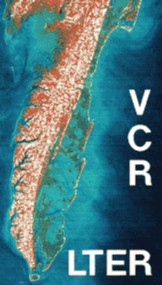 Long-term Monitoring of Vegetation Dynamics on the Hog Island Chronosequence |

Frank P. Day, Everett Weber and Edward Crawford
Dept. of Biological Sciences
|
 Long-term Monitoring of Vegetation Dynamics on the Hog Island Chronosequence |

Frank P. Day, Everett Weber and Edward Crawford
Dept. of Biological Sciences
|
The long-term nitrogen fertilized plots were fertilized again in July 1996 and all control and fertilized plots were inventoried. Plant density and cover were quantified by species. We now have five years of data from these permanent plots, and responses in community composition to fertilization are becoming apparent in addition to the previously recognized increases in production. In general, Ammophila breviligulata appears to be increasing in importance in fertilized areas of the mid-island dunes; the inverse is apparent for Spartina patens. Also, in August, aboveground vegetation on the dunes was harvested in 15 1-m2 plots and biomass was determined by species. Along with the harvests we obtained in 1993, this represents the beginning of a long-term data set on dune biomass with observations at least at three year intervals.
Observations were recorded in the minirhizotron tubes in May and October. We now have five growing seasons of data from these tubes. The longer term data suggest that there are different classes of roots based on longevity and this probably relates to functional differences. Reported life history responses of roots to fertilization have been varied. In some studies root turnover has increased in response to fertilization, and in others turnover has decreased. Three years of analyzed data show that fine roots in the fertilized sites on Hog Island have a mean lifespan (2.1 months) roughly twice that of those in the unfertilized areas (1.2 months). The unfertilized plots tended to have a higher percentage of new roots. Fertilization appears to decrease turnover by increasing the lifespan of individual roots. Rett Weber's dissertation project is addressing questions related to differential responses of root systems in different nutrient regimes to additional nutrient inputs and includes LTER cross site research with a portion of his work conducted at Konza Prairie in cooperation with John Blair.
The ground water wells continue to be maintained monthly. We now have six years of continuous data on ground water levels across the chronosequence.